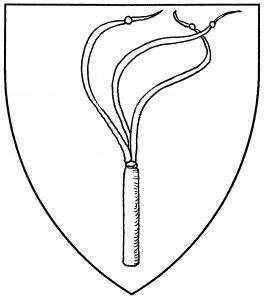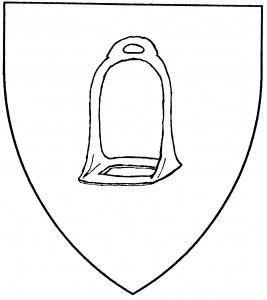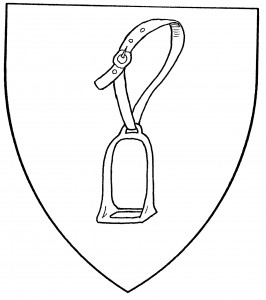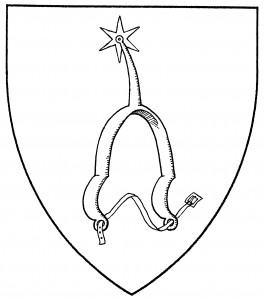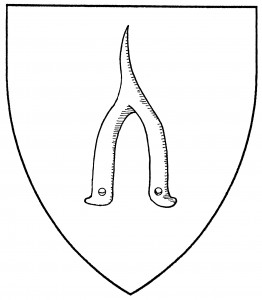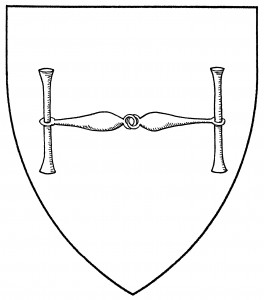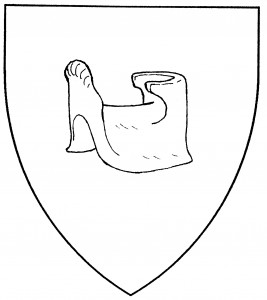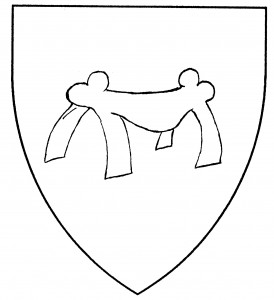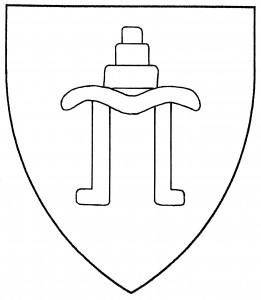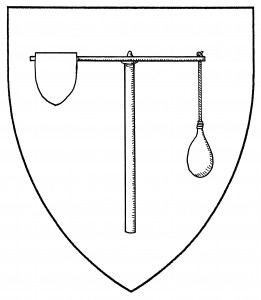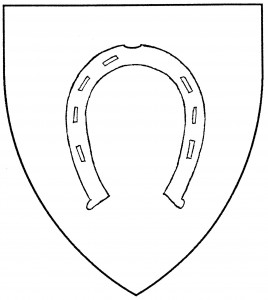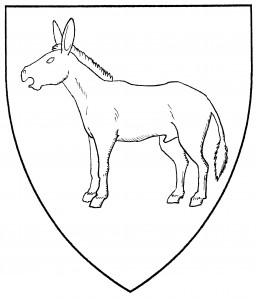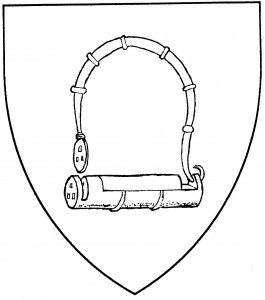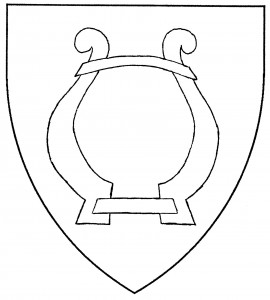Deadra Colin Madoc bears: Argent, a drover’s whip bendwise sinister, lash in action sable.
Valgard Stonecleaver bears as a badge: Or, a scourge sable.
Archives
Stirrup
A stirrup is a footrest for horse riders, a flat-bottomed ring of metal hung by a strap from the saddle. The standard heraldic form is the English stirrup; it is sometimes so blazoned. It’s a period charge, dating from 1308 in the arms of Kydemore [ANA2 549].
In medieval heraldry, the stirrup was usually drawn “leathered”, i.e., showing a bit of strap, though there are examples of unleathered stirrups as well (e.g., the badge of Gyfford, c.1520 [Walden 201]); in Society heraldry, the leather is not shown unless blazoned. The Society also has a single example of a “stirrup-cup”, which is identical to an inverted escutcheon in shape; this charge is unattested in period armory. See also spur.
The Order of the Golden Stirrup, of Æthelmearc, bears: A stirrup Or leathered gules.
Berengaria de Hainault bears: Azure, three stirrups Or, leathered argent.
Meadhbh inghean ui Bhaoighill bears: Per fess azure and Or fretty azure, a stirrup Or.
Spur
A spur is a pointed piece of metal worn on a rider’s heel to urge the horse forward. The default form of spur is the roweled spur, with a six-pointed mullet attached to a U-shaped frame and buckle. It’s a period charge, found in the canting arms (Italian sperone) of Speroni, c.1555 [BSB Cod.Icon 275:65], and as the crest of Matela, c.1540 [Nobreza xxixº].
In mundane armory, the spur is frequently drawn with leather straps; in Society armory, these are left to the artist’s license. While some sources give the spur’s default orientation as having the rowel to base, the majority [Franklyn 312; Guide 215] put the rowel to chief, and this is the Society’s default for the spur as well.
Society armory also has the “prickspur”, which has no rowel, but simply comes to a point. Its default orientation is the same as for the roweled spur, with the point to chief, and no difference is counted between the types. See also stirrup.
Harrys Rob of Wamphray bears: Vert, a chevron between three winged spurs argent.
Taliesynne Nycheymwrh yr Anghyfannedd bears: Quarterly sable and gules, on a unicorn rampant contourny argent gorged of a pearled coronet sable, a prickspur Or fimbriated sable.
Snaffle-bit
A snaffle-bit is the part of the bridle which goes into the horse’s mouth; the rider controls the horse through direct pressure, without leverage. It’s a period charge, found in the arms of von Wierrant, 1605 [Siebmacher 40], and of Kasattel, mid-16th C. [BSB Cod.Icon 392d:542; cf. Parker 63]. It’s sometimes blazoned, a bit redundantly, as a “riding snaffle-bit”. The snaffle-bit is fesswise by default.
Period forms of the snaffle-bit have a bar or curb at either end, to keep it from slipping from the horse’s mouth; and a ring, to attach the reins. While a snaffle-bit could be a solid bar, by far its most usual form is jointed in the center (as in the illustration); it is thus usually blazoned a “broken snaffle-bit” in the Society. (“Broken” here refers to the joint; it doesn’t mean the bit is fracted.) Society armory often emphasizes the joint by arranging the snaffle-bit in chevron.
There’s one Society example of a “double-strand snaffle-bit”, which is simply a broken snaffle-bit whose central part is made from two braided wires rather than a solid metal bar.
For related charges, see bridle.
Shishido Tora bears: Per bend sinister gules and sable, a snaffle-bit Or and an eagle argent.
Elizabeth de la Vigne bears: Vert, a broken snaffle-bit chevronwise argent and in base a sun Or.
Alail Horsefriend bears as a badge: A double-strand snaffle-bit fesswise.
Saddle
A saddle is a padded leather seat for the rider of a horse or camel. It’s normally found as part of a horse’s equipage, but may be used as a charge in its own right, as in the arms of the Worshipful Company of Saddlers, 1585 [Bromley & Child 211], and the canting arms of Sattelin, 1605 [Siebmacher 117]. The horse’s saddle is the default, unless otherwise specified. The stirrups, if shown, must be explicitly blazoned; in mundane heraldry, the phrase “saddle complete” may be used for this.
The term “selle” is an obscure synonym for “saddle”, derived from Old French, and usually used only for canting.
The 19th Century saddle of the American West should not be used in Society emblazonry; a period saddle should be shown instead. The illustrations show a 14th Century tournament saddle and a camel saddle. When “proper”, the saddle is brown leather; the saddle’s front faces dexter by default.
Saracenic heraldry gives us the “Arabic ceremonial saddle”, a highly stylized charge, found in the arms of Musa an-Nasiri, d.1355 [Mayer 168].
The Order of the Silver Saddle of Trimaris bears: Per fess azure and vert, a tournament saddle argent.
Fatima al-Mendizayya bears: Argent, in pale a leather camel saddle proper, two scimitars in saltire sable, and a pavilion, all within a bordure vert.
Anne de Fountain of Seldom Rest bears: Tierced in point purpure, gules and vert, a fountain between a selle, a dome, and a rest Or.
Salim ibn abd al-Rahman al-Rashid bears: Argent, two crescents sable and a fleur-de-lys azure, on a point pointed sable an Arabic ceremonial saddle argent.
Quintain
A quintain is a target for tilting practice, consisting of a post with a pivoted crosspiece, armed with a wooden shield, and often a sandbag for counterbalance. The rider would attempt to strike the quintain with his lance as he rode by; missing the shield would leave it in the rider’s path, but striking at too slow a speed would cause the sandbag to clout the rider as it swung around! Though a period artifact, the quintain does not appear in period armory; the illustration is taken from a 14th Century psalter [Barber & Barker, Tournaments, p.27].
Lorenzo Quintain bears: Argent, a quintain armed to dexter with a sword bendwise and to sinister with a shield, gules.
Philip Rufus Kennard bears: Erminois, a quintain gules and a base nebuly vert.
Horseshoe
A horseshoe is a U-shaped metal plate, nailed to a horse’s hoof for its protection. It’s an ancient heraldic charge, dating from c.1280, in the canting arms of Ferrers [ANA2 216]. The horseshoe has its opening to base by default; it is conventionally drawn with seven nail-holes. See also axle bracket.
Caitilín Mhór bears: Per pale azure and Or, a horseshoe inverted counterchanged.
Joanna of the Plains bears: Sable, four horseshoes openings to dexter two and two Or.
Selfran the Singer bears: Azure, in cross five horseshoes inverted Or.
Horse; Ass
The horse is a large, strong equine beast used for riding, drawing loads, and other burdens. As the chivalry’s special beast, it was considered among the noblest of animals; it was also the medieval archetype of virility and passion. The horse is an ancient charge, found (bridled and saddled) in the arms of an early King of Norway, c.1275 [ANA2 57].
The default horse is the stallion, the adult male. Period armory includes examples of the young horse, blazoned a “colt” or “foal” (the latter in the arms of Falyngbrome, 1465 [DBA1 204]). Society armory includes the female horse, or “mare”. No difference is granted for these distinctions.
The horse is sometimes blazoned “forceny”, literally “enraged”: the term denotes a posture halfway between rampant and salient. Since the posture is too easily confused with rampant and salient, and since the term seems to have been first used in the 18th Century, “forceny” currently is not used in Society blazons. (Some of the Society’s early blazons use the term.) There doesn’t seem to be a default posture for the horse; the illustration shows a horse rampant.
Horses may be shown bearing a rider, as in the arms of Lithuania, c.1413 [Conz.Const. cxlix]; saddled; bridled; or “caparisoned”, i.e., wearing barding and fully equipped. These circumstances must be blazoned.
Similar to the horse is the “ass” or “jackass”, found in the arms of Riethiem, 1605 [Siebmacher 30]. Society blazons have also used the modern term “donkey” for this beast. Like the horse, the ass doesn’t seem to have a default posture; the illustration shows an ass statant.
Society armory also has examples of the “mule”, a hybrid of the horse and ass, and the “onager” or Asian wild ass; these are heraldically indistinguishable from the ass, but no explicit examples have been found in period armory.
Instances are found in Society armory of the “Trojan horse”, a horse statant upon a wheeled platform; and of the “eight-legged horse”, a monster representing Odin’s horse Sleipnir. The latter is not encouraged for Society use, because of the visual confusion from its limbs.
For related charges, see centaur, pegasus, sea-horse, unicorn. See also hobbyhorse.
The Order of the Cheval d’Or, of Artemisia, bears: A horse courant contourny Or.
The College of Scola Metallorum bears: Azure, a donkey rampant contourny argent within a laurel wreath Or.
Anne Pomeroy of Woodswell bears: Countervair, a mare courant reguardant Or.
Elena Catalina Santangelo y Fernandez bears: Purpure, three horses rampant argent.
Fionnghuala Gliobach Mael Ailbe bears: Gules, a horse passant contourny with a maintained female rider Or.
Troy of Nodham Whyre bears: Purpure, a Trojan horse between three decrescents argent.
Halla Brandsdottir bears: Or, an eight-legged horse passant contourny within a bordure sable charged with dolphins naiant argent.
Fetterlock
A fetterlock is a semi-circular manacle, put on a horse’s ankle to prevent it from running away. It is open (unlocked) by Society default. While the bolt mechanism may be either to chief or to base in mundane heraldry, the most common attitude is with bolt to base, as in the Yorkist badge of the fetterlock-and-falcon, used since Edward IV [Hope2 169, HB 97]; this is the Society default. For related charges, see padlock, shackle.
Mons von Goarshausen bears: Per pale gules and sable, three closed fetterlocks Or.
Nikolai Jagger bears: Per chevron gules and sable, a fetterlock within a bordure argent.
Marsle Lokart bears: Azure, a closed fetterlock argent and in chief three hearts Or.
Collar
A collar is a band, circlet, or shackle that fits around the neck. The charge is most often found around the neck of a beast; such a beast may be blazoned “collared” or “gorged”, and the collar may trail a chain.
There are instances, however, of a collar used as an independent charge: e.g., the “pair of hames” or horse collar. It was used in the badge of Marcam or Markham, c.1520 [Walden 265; Parker 302]. See also shackle.
The Equestrian Champion of Gleann Abhann bears: A chamfron argent within and conjoined with a pair of hames per pale gules and sable.
Aureliane Rioghail bears as a badge: A pair of hames Or.
Micheil, Younger of An Alltan bears as a badge: A demi-boy proper crined Or, vested and wearing a mail collar argent.
